There are no more kings of Vietnam, but the old royal city of Hue sits midway between Ho Chi Minh City/Saigon in the south and Hanoi in the north. More aptly it was located far enough from the original royal city of Hanoi to satisfy the founders of the last reigning dynasty of Vietnam.
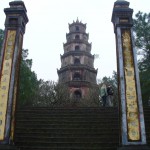
In a sense, the Nguyen family (pronounced WHYNN, roughly) left Hanoi for Hue (pronounced HWAY, or HOY, roughly) to build empires twice. First, in 1601, they move away from the center of power to create a land and business empire that eventually spread southward to the Mekong delta. Right next to the Perfume River that runs through Hue, the towering hillside Thien Mu Pagoda was their first declaration of power in the form of a spiritual testament to their Buddhist faith. Then at the beginning of the 19th century, they gained power over the kingdom themselves and founded the royal dynasty that lasted about 150 years until 1945.
The kings are gone from Vietnam, overturned by their increasing irrelevance and worse in the 20th century. From the mid 1800s, their reign was propped up by the French, who of course had tossed out their own royalty some years before. However, like other European colonialists, the French found the aura and administrative structure around the king quite useful to their interests. When the French lost their hold on the country after World War II, the simmering popular discontents finished off the empire, as Ho Chi Minh and his communist regime gained power in the north. In the 60s, the U.S. apparently made the mistake of siding with the last king, by then resident in Paris, whose fondness for French Catholicism led JFK to prop up a Catholic as president of South Vietnam. And it was that ruler’s ill-conceived campaign against Buddhism that turned the monks and popular opinion irrevocably against the south’s government, the king and the now colonialising U.S. The monk that immolated himself in 1962 as a religious protest, and whose passion should have exposed our folly, came fittingly from that monastery at the Hue pagoda.
Beyond this legacy, the royal imprint on the country survives in the popularity of their name: a lot of people are named Nguyen. Moreover, its imprint on Hue is the reason you visit here. Few signs of the kings in Hanoi are left, but here you see those structures that have survived the internal and American wars, and that still demonstrate the power, wealth and privilege that the Nguyens enjoyed.
Those qualities are amply demonstrated by the manner in which the kings decided to spend eternity, the elaborate mausoleums they built on the outskirts of the town. You would not find these anywhere else in SE Asia, for the Vietnamese – following more the Buddhist traditions of China – bury their dead, rather than cremate. And it is the responsibility of later generations to honor and appease those dead spirits by at least annual visits to the burial sites. For farmers, that means they put cemeteries in the middle of their fields, and in effect cannot sell those plots to others. For the kings, that meant enormous royal tombs, each designed as he preferred to live, so that their successors could visit them.
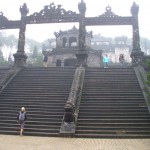
The last king didn’t have a chance to do this, as he lit out for Paris while he had the chance. For his predecessor, Khai Dinh, a mausoleum meant creating an imitation of a royal palace in which his remains could abide. That monumental tomb rises through several levels up a hillside overlooking the river valley, each level corresponding to areas in the royal palace: the entry courtyard, the ceremonial gathering place for the court attendants, and the palace itself.
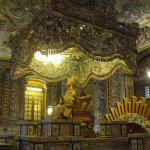
As that king was a Francophile and regular visitor to Paris, his design is a hybrid of French baroque frou-frou and ironwork, marbles and other materials imported from Europe, plus traditional Vietnamese symbols like the dragon and phoenix along with furnishings for the good after-life represented in mosaics. Ironically, this king died young before he could even finish the structure that took an army of artisans to create.
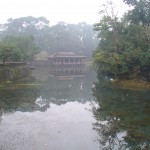
It’s a far different after-life that the fourth Nguyen emperor, Tu Duc, chose in the 1860s. A lover of Chinese gardens and architecture, as well as a poet himself, he designed a retreat from the imperial center that he actually used as a summer palace. Much longer-lived, he was able to enjoy the place for 16 years before he died. Within this edenic sanctuary, he could compose poems at the simple wood pavilion that still sits in the man-made lake. He could fish in the lake and hunt rabbit on the island created within it. He could enjoy Chinese opera productions in what is now the oldest remaining theatre of Vietnam. And he could choose to spend time in the still surviving main rooms with any of the more than 100 concubines he and his mother had carefully selected. Though the actual mausoleum within this garden is fairly plain, clearly it was good to be the king, in life or in death.
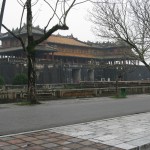
No less grand are the buildings of the Imperial City where the royal court lived within central Hue. Only a few of the original 150 within the massive walls of the fortress-like citadel have survived the fall of the lineage. Natural collapse and even more destruction from the wars finished off the rest. The remainder demonstrate, however, an ambition and wealth whose scope took the Forbidden City of the Chinese at its model, and whose details mark the grandest achievement of imperial Vietnamese style.

Now, however, they no longer host the high-living kings and their retinue. The remnants are for tourists and commoners to tramp on and gawk at, somewhat envious perhaps of a royal lifestyle that has so recently passed on.
(For more pictures from Vietnam, CLICK HERE to view the slideshow at the end of the Vietnam itinerary page.)

